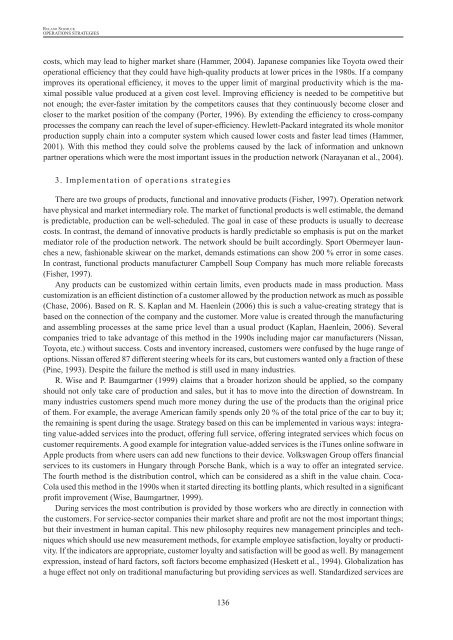regional formation and development studies - KlaipÄdos universitetas
regional formation and development studies - KlaipÄdos universitetas
regional formation and development studies - KlaipÄdos universitetas
Create successful ePaper yourself
Turn your PDF publications into a flip-book with our unique Google optimized e-Paper software.
Rol<strong>and</strong> Schmuck<br />
OPERATIONS STRATEGIES<br />
costs, which may lead to higher market share (Hammer, 2004). Japanese companies like Toyota owed their<br />
operational efficiency that they could have high-quality products at lower prices in the 1980s. If a company<br />
improves its operational efficiency, it moves to the upper limit of marginal productivity which is the maximal<br />
possible value produced at a given cost level. Improving efficiency is needed to be competitive but<br />
not enough; the ever-faster imitation by the competitors causes that they continuously become closer <strong>and</strong><br />
closer to the market position of the company (Porter, 1996). By extending the efficiency to cross-company<br />
processes the company can reach the level of super-efficiency. Hewlett-Packard integrated its whole monitor<br />
production supply chain into a computer system which caused lower costs <strong>and</strong> faster lead times (Hammer,<br />
2001). With this method they could solve the problems caused by the lack of in<strong>formation</strong> <strong>and</strong> unknown<br />
partner operations which were the most important issues in the production network (Narayanan et al., 2004).<br />
3. Implementation of operations strategies<br />
There are two groups of products, functional <strong>and</strong> innovative products (Fisher, 1997). Operation network<br />
have physical <strong>and</strong> market intermediary role. The market of functional products is well estimable, the dem<strong>and</strong><br />
is predictable, production can be well-scheduled. The goal in case of these products is usually to decrease<br />
costs. In contrast, the dem<strong>and</strong> of innovative products is hardly predictable so emphasis is put on the market<br />
mediator role of the production network. The network should be built accordingly. Sport Obermeyer launches<br />
a new, fashionable skiwear on the market, dem<strong>and</strong>s estimations can show 200 % error in some cases.<br />
In contrast, functional products manufacturer Campbell Soup Company has much more reliable forecasts<br />
(Fisher, 1997).<br />
Any products can be customized within certain limits, even products made in mass production. Mass<br />
customization is an efficient distinction of a customer allowed by the production network as much as possible<br />
(Chase, 2006). Based on R. S. Kaplan <strong>and</strong> M. Haenlein (2006) this is such a value-creating strategy that is<br />
based on the connection of the company <strong>and</strong> the customer. More value is created through the manufacturing<br />
<strong>and</strong> assembling processes at the same price level than a usual product (Kaplan, Haenlein, 2006). Several<br />
companies tried to take advantage of this method in the 1990s including major car manufacturers (Nissan,<br />
Toyota, etc.) without success. Costs <strong>and</strong> inventory increased, customers were confused by the huge range of<br />
options. Nissan offered 87 different steering wheels for its cars, but customers wanted only a fraction of these<br />
(Pine, 1993). Despite the failure the method is still used in many industries.<br />
R. Wise <strong>and</strong> P. Baumgartner (1999) claims that a broader horizon should be applied, so the company<br />
should not only take care of production <strong>and</strong> sales, but it has to move into the direction of downstream. In<br />
many industries customers spend much more money during the use of the products than the original price<br />
of them. For example, the average American family spends only 20 % of the total price of the car to buy it;<br />
the remaining is spent during the usage. Strategy based on this can be implemented in various ways: integrating<br />
value-added services into the product, offering full service, offering integrated services which focus on<br />
customer requirements. A good example for integration value-added services is the iTunes online software in<br />
Apple products from where users can add new functions to their device. Volkswagen Group offers financial<br />
services to its customers in Hungary through Porsche Bank, which is a way to offer an integrated service.<br />
The fourth method is the distribution control, which can be considered as a shift in the value chain. Coca-<br />
Cola used this method in the 1990s when it started directing its bottling plants, which resulted in a significant<br />
profit improvement (Wise, Baumgartner, 1999).<br />
During services the most contribution is provided by those workers who are directly in connection with<br />
the customers. For service-sector companies their market share <strong>and</strong> profit are not the most important things;<br />
but their investment in human capital. This new philosophy requires new management principles <strong>and</strong> techniques<br />
which should use new measurement methods, for example employee satisfaction, loyalty or productivity.<br />
If the indicators are appropriate, customer loyalty <strong>and</strong> satisfaction will be good as well. By management<br />
expression, instead of hard factors, soft factors become emphasized (Heskett et al., 1994). Globalization has<br />
a huge effect not only on traditional manufacturing but providing services as well. St<strong>and</strong>ardized services are<br />
136

















